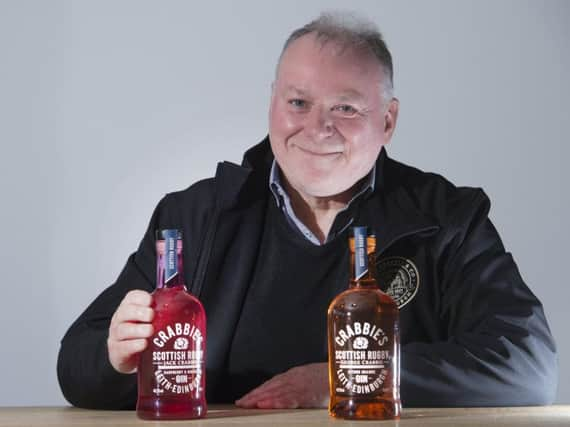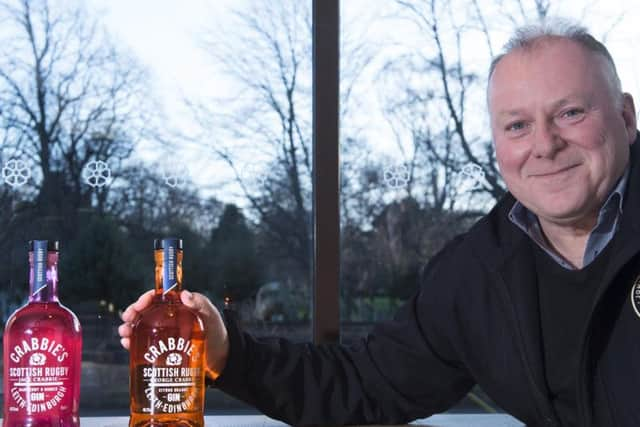The Big Interview: John Crabbie & Company MD David Brown


It even boasts a character who came out of semi-retirement for “one last job” – David Brown, an Edinburgh born and raised drinks industry veteran who now leads the firm from the MD’s hotseat.
The call came after decades of high-profile work at the likes of Whyte & Mackay and Belhaven Brewery, and he had latterly turned his attentions to The Glasgow Distillery Company, which had re-opened in 2014 claiming to be the first single malt whisky distillery to open in the city in more than 100 years.
Advertisement
Hide AdAdvertisement
Hide Ad“I was quite happy just to end my career there and do that,” he says. But he was approached by wine and spirit firm – and Crabbie’s parent company – Halewood, which asked him if he’d like to build a distillery in his home city. “And then they started to tell me about this Crabbie story… I said, ‘Go on, then.’ The rest, as they say, is history. It nearly killed me, but it’s been worth it.”


Brown was drafted in to revive the spirits arm of the business, with the organisation able to trace its roots back to 1801. John Crabbie, who was born into a thriving grocery and spirit merchant family business, capitalised on the port of Leith to access ginger and exotic spices – also making pioneering in-roads into whisky and gin.
The firm, officially known as John Crabbie & Company, has been investing in this side of its operations with distilleries in both Edinburgh’s Granton, which opened in 2018, and a £7 million facility in Leith, which is now producing whisky and gin. A visitor centre is set to open this summer at what will be the company’s base going forward.
Crabbie’s now also sells two gins that launched last year along with two liqueurs (one ginger and one wildberry) which have proved a hit, securing listings in high-end retailers and some supermarkets.
Launch
They are now being joined by two additions that launched on Friday and take inspiration from John Crabbie’s grandsons George and Jack, who both played rugby for Scotland in the early 1900s. “Even better for us, Jack Crabbie scored the winning try in the Calcutta Cup in 1904,” says Brown proudly. Scotland and England will vie for the trophy when they meet at Murrayfield this Saturday.
Crabbie’s return to gin came about after the discovery of one treasure in the “Pandora’s Box” of its archive.
Among the boxes was what looked like a recipe book, whose pages were “completely welded together”, says Brown, explaining that head distiller Marc Watson, formerly of Fife beer and spirits firm Eden Mill, prised them open with a palette knife. “To his utter astonishment, inside there were a load of gin recipes.”
One dating back to 1837, the oldest gin recipe around to the team’s knowledge, has been incorporated into the two new products.
Advertisement
Hide AdAdvertisement
Hide AdThey are the “George Crabbie”, flavoured with orange, and the “Jack Crabbie” made with Scottish raspberries and ginger. “What’s really in vogue right now is pink gin – you can’t make enough of the stuff,” says Brown.
They have been designed to stand out in a busy market. According to the latest data from the Wine and Spirit Trade Association, gin sales grew 40 per cent by volume and 42 per cent by value over the last recorded 12 months as the “ginaissance” continues.
But who are the two new Crabbie’s gins aimed at – the casual drinker or the connoisseur? “Realistically, it’s probably more somebody who wants to know a bit of a backstory about it,” says Brown. They’re not just looking for a quick G&T, they actually want to know what’s in their drink… People want to know a lot more about why you’ve made your whisky or your gin or whatever it is you’re making.”
Starting gun
He describes the company’s move into gin as the “starting gun” for Crabbie spirits production in Leith for the first time in a century, and the two new Scottish Rugby gins its most important new product launches so far. “These gins are really vital,” he continues.
The tie-up also comes hot on the heels of Crabbie’s being named Scottish Rugby’s official gin partner (Diageo’s Johnnie Walker is the chosen whisky) while the governing body has also renewed its partnership with Crabbie’s Ginger Beer.
“We had the players down at the distillery – we had a lot of fun horsing around with gin and making up cocktails and all sorts of things.”
Crabbie’s also sponsors Edinburgh Rugby – and Brown is keen to stress that the firm is one of the few to actually make its gin in the Scottish capital.
“I’m not going to go casting aspersions on anyone else – that would be wrong of me to do so – but there are a lot of gin brands and not many distilleries, let me just put it that way. We make this stuff.”
Advertisement
Hide AdAdvertisement
Hide AdCrabbie’s is “just woven into the fabric of Edinburgh as long as most people can remember,” according to Brown, who early on in his career was given the dramatic task of literally burning money.
While it might bring to mind the anarchic team behind pop band The KLF burning £1m in cash on Jura, Brown was in fact working for Royal Bank of Scotland, tasked with destroying notes that couldn’t be dispensed from new ATMs. “My job title was ‘the responsible person’ – how little they knew,” he jokes.
Then, he “turned to drink” professionally, including spells at Allied Domecq, which saw him looking after brands such Beefeater Gin, Laphroaig whisky and Courvoisier cognac.
Triumph
He then arrived at the Caledonian Brewery, which under his guidance underwent a major overhaul and won Champion Beer of Britain two years later (“like a complete unknown winning an Oscar”) and attracting the attention of Scottish & Newcastle. “Then I went from there to Belhaven, which became part of Greene King.”
This was followed by nearly a decade at Whyte & Mackay, where he was sales director, then moving to The Glasgow Distillery Company.
He started at Crabbie’s two years ago, plugging into a firm where it was in fact Mrs Crabbie who had come up with the green ginger wine recipe – and the move to turn it into a ready-to-drink ginger beer led to it becoming the UK’s top-selling product of its kind.
Brown notes that without her, the brand would not be where it is today. “This one thread that has carried on for 200 years, that’s been a continuous thing… otherwise this would just be another defunct family brand, and there’s hundreds of those in history that will never be brought back to life. So, good old Mrs Crabbie, I say.”
Additionally, the firm’s distilling team is 50 per cent female.
Advertisement
Hide AdAdvertisement
Hide AdThe firm is harking back to when John Crabbie built a small distillery in Leith, producing whisky and gin, but this side of the business was taken on by DCL, which effectively became part of Diageo.
However, bringing to life the new Leith site – just a few hundred yards from the original – has “not been without its challenges”, Brown states. “None of us could possibly have imagined that they would find the lost mansion of Edinburgh [under the floor]. I didn’t know we’d lost a mansion, but it turns out we did, in the 11th century. And that then led on to all sorts of other discoveries about the area.”
Epicentre
All in all, on-site archaeological finds delayed proceedings by about a year. Additionally, Crabbie’s decided to call the facility the Bonnington Distillery. And it turned out that there had been another distillery of the same name on the same site many years previously.
Brown points out that Edinburgh used to be the “epicentre” of the drink world for Scotland, with about 60 breweries that all tapped into locally available, high-quality volcanic water.
Crabbie’s has now decided to access this by drilling a borehole for this “good old Edinburgh water”. Brown says: “Nobody’s been using this resource for years and years until we started.”
A further nod to the past is the elephant icon on Crabbie’s product labels, a reference to when John Crabbie went to Sri Lanka to see where the ginger was coming from – and was totally taken with the creatures. This aspect of the Crabbie’s story will feature prominently at the distillery, says Brown.
Additionally, the business has joined forces with the Millennium Elephant Foundation in Sri Lanka to adopt three of the animals.
“We’ve got an amazing history and heritage story and that has to be told – it’s too good not to…you’ve got to keep making yourself fresh and relevant”.
Advertisement
Hide AdAdvertisement
Hide AdOn the cards is a potential expansion of the rugby gin range, perhaps in celebration of the other Six Nations participants, with export also a priority.
All in all, the drinks industry has undergone a considerable conversion from when pubs would simply have one gin on offer. “This is what I keep telling all our sales people,” he exclaims. “They don’t realise they are living in a golden era – particularly when it comes to gin.”
